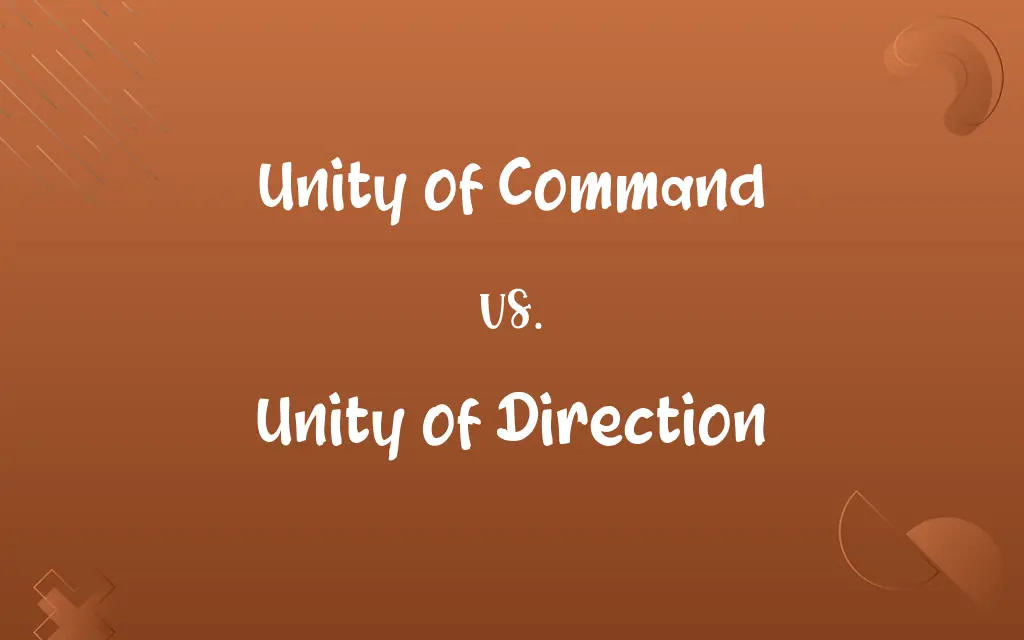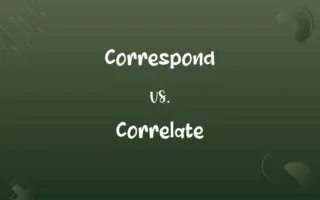Unity of Command vs. Unity of Direction: Know the Difference

By Shumaila Saeed || Updated on December 25, 2023
Unity of Command is the principle where each employee reports to one manager, ensuring clear, direct authority & responsibility. Unity of Direction is when teams with the same objective follow one plan & one leader, aligning their efforts towards goals.

Key Differences
Unity of Command ensures individual accountability by having each employee report to only one supervisor, avoiding conflicting orders and responsibilities. Unity of Direction, however, aligns multiple departments or groups under one plan and leader for a single objective, ensuring collective efforts are harmonious and directed towards the same end.
Shumaila Saeed
Dec 23, 2023
Unity of Command focuses on the clarity of reporting relationships within an organization, ensuring that each employee has one clear supervisor. This simplification of authority streamlines decision-making and accountability. In contrast, Unity of Direction concerns the overall alignment of activities and resources in an organization, directing diverse efforts towards unified objectives and strategies.
Shumaila Saeed
Dec 23, 2023
In Unity of Command, the emphasis is on preventing confusion and conflict among employees caused by multiple supervisors. It establishes a straightforward hierarchical structure. Unity of Direction, on the other hand, emphasizes the coherence of actions and strategies across different parts of an organization, ensuring that all units move in concert towards shared goals.
Shumaila Saeed
Dec 23, 2023
Unity of Command is crucial for maintaining discipline and order within an organization, as it clarifies who is responsible for what task. Unity of Direction, conversely, is key to strategic planning and execution, ensuring that all parts of the organization are working effectively towards common objectives.
Shumaila Saeed
Dec 23, 2023
The principle of Unity of Command is vital in managing individual performance and resolving accountability issues. Unity of Direction, however, is essential for organizational effectiveness, ensuring that all efforts are synergistically aligned towards the organization’s mission and vision.
Shumaila Saeed
Dec 23, 2023
ADVERTISEMENT
Comparison Chart
Focus
Individual reporting and accountability
Alignment of group efforts and strategies
Shumaila Saeed
Dec 23, 2023
Organizational Structure
Clear hierarchical reporting lines
Unified planning and leadership across departments
Shumaila Saeed
Dec 23, 2023
Key Benefit
Prevents confusion and conflict from multiple orders
Ensures cohesive action towards common goals
Shumaila Saeed
Dec 23, 2023
Importance
Crucial for individual discipline and order
Essential for effective strategic planning
Shumaila Saeed
Dec 23, 2023
Application
Managing individual performance and accountability
Aligning departmental efforts with organizational goals
Shumaila Saeed
Dec 23, 2023
ADVERTISEMENT
Unity of Command and Unity of Direction Definitions
Unity of Command
Unity of Command simplifies accountability by assigning one boss per employee.
Each salesperson reporting to a single sales manager is an application of Unity of Command.
Shumaila Saeed
Dec 14, 2023
Unity of Direction
It focuses on unified strategic planning across different departments.
The company's synchronized approach to market expansion demonstrates Unity of Direction.
Shumaila Saeed
Dec 14, 2023
Unity of Command
Unity of Command is about exclusive reporting relationships in an organizational hierarchy.
Her direct reporting to the marketing manager is a clear case of Unity of Command.
Shumaila Saeed
Dec 14, 2023
Unity of Direction
It's the alignment of activities and efforts of different teams towards a single plan.
Different departments collaborating on the product launch is an example of Unity of Direction.
Shumaila Saeed
Dec 14, 2023
Unity of Command
This principle ensures a single line of authority in an organization.
The team leader’s sole authority over his team members demonstrates Unity of Command.
Shumaila Saeed
Dec 14, 2023
ADVERTISEMENT
Unity of Direction
Unity of Direction ensures coordinated efforts under one leadership for a single objective.
The joint marketing and sales strategy for the new product reflects Unity of Direction.
Shumaila Saeed
Dec 14, 2023
Unity of Command
It's a principle where an individual receives orders from only one superior.
To avoid confusion, the factory workers take instructions only from the foreman, maintaining Unity of Command.
Shumaila Saeed
Dec 14, 2023
Unity of Direction
Unity of Direction means all parts of an organization working towards a common goal.
The entire company focusing on customer satisfaction showcases Unity of Direction.
Shumaila Saeed
Dec 14, 2023
Unity of Command
Unity of Command means each employee has only one direct supervisor.
In the company, every staff member reports solely to their department head, exemplifying Unity of Command.
Shumaila Saeed
Dec 14, 2023
Unity of Direction
This principle involves harmonizing various organizational activities towards shared goals.
Unity of Direction is evident when the R&D and production teams work together on innovation.
Shumaila Saeed
Dec 14, 2023
Repeatedly Asked Queries
What is Unity of Command?
Answer: Unity of Command is a principle where each employee reports to only one supervisor, ensuring clear authority and responsibility.
Shumaila Saeed
Dec 23, 2023
Why is Unity of Command important in an organization?
Answer: It's important for maintaining clear lines of authority, preventing confusion, and ensuring individual accountability.
Shumaila Saeed
Dec 23, 2023
How does Unity of Command prevent conflicts in the workplace?
Answer: By having each employee report to only one manager, it prevents conflicting instructions and responsibilities.
Shumaila Saeed
Dec 23, 2023
Does Unity of Direction require a single leader for multiple teams?
Answer: Yes, it often involves a single leader guiding various teams towards a shared objective.
Shumaila Saeed
Dec 23, 2023
How does Unity of Direction differ from Unity of Command?
Answer: Unity of Direction aligns multiple departments under one plan for a single objective, whereas Unity of Command focuses on individual reporting relationships.
Shumaila Saeed
Dec 23, 2023
Can Unity of Command be applied in virtual or remote work settings?
Yes, Unity of Command can be adapted to virtual work environments by clearly defining reporting relationships and using communication tools effectively.
Shumaila Saeed
Dec 23, 2023
What are the benefits of maintaining Unity of Direction in an organization?
Benefits include improved coordination, enhanced focus, and increased efficiency in pursuing organizational objectives.
Shumaila Saeed
Dec 23, 2023
Can Unity of Direction affect strategic planning?
Answer: Yes, it ensures that all departments and teams are aligned towards the organization’s strategic goals.
Shumaila Saeed
Dec 23, 2023
Can Unity of Command apply to small businesses?
Answer: Absolutely, it's applicable in businesses of all sizes for clear reporting and accountability.
Shumaila Saeed
Dec 23, 2023
How does Unity of Command contribute to organizational efficiency?
It streamlines decision-making, reduces conflicts, and ensures clear lines of authority, ultimately enhancing efficiency.
Shumaila Saeed
Dec 23, 2023
Who introduced the concept of Unity of Command?
Henri Fayol, a management theorist, is often credited with introducing the concept of Unity of Command in his principles of management.
Shumaila Saeed
Dec 23, 2023
Can Unity of Direction be maintained in decentralized organizations?
Yes, decentralized organizations can still maintain Unity of Direction by clearly communicating and aligning strategic goals throughout the organization.
Shumaila Saeed
Dec 23, 2023
How is Unity of Direction related to strategic alignment?
Unity of Direction is closely related to strategic alignment, as it ensures that all organizational activities align with the overarching strategy.
Shumaila Saeed
Dec 23, 2023
Does Unity of Command mean no collaboration or teamwork?
No, Unity of Command doesn't imply that employees cannot collaborate. It focuses on hierarchical reporting and decision-making.
Shumaila Saeed
Dec 23, 2023
Share this page
Link for your blog / website
HTML
Link to share via messenger
About Author
Written by
Shumaila SaeedShumaila Saeed, an expert content creator with 6 years of experience, specializes in distilling complex topics into easily digestible comparisons, shining a light on the nuances that both inform and educate readers with clarity and accuracy.






































































